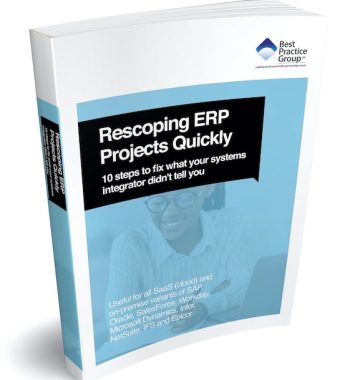 In a recent article we looked at what experience tells us should be involved in good contract management and supplier relationship management within complex projects, and the main differences between the two disciplines. In this article, we look at the flip side of this consideration as we review the risks to your organisation if you encounter challenges in effectively managing your strategic supplier relationships.
In a recent article we looked at what experience tells us should be involved in good contract management and supplier relationship management within complex projects, and the main differences between the two disciplines. In this article, we look at the flip side of this consideration as we review the risks to your organisation if you encounter challenges in effectively managing your strategic supplier relationships.
Potential strategic supplier management risks
A strategic supplier is a vendor that provides strategic and/or complex services that are essential to your organisation. Any material issues in managing these relationships, or the contracts that govern them, could have serious adverse implications for your organisation.
Some potential supplier management risks include:
- Disruption in Operations: If a strategic supplier’s performance is poor, it can halt production or service delivery, which can be particularly detrimental if there are no suitable alternatives available.
- Financial Loss: Non-performance or delays from a supplier on a complex project often leads to financial losses. These losses might result from disruption in operations, increased costs, penalties from delayed deliveries to your customers, or having to find and switch to a more expensive supplier.
- Damage to Reputation: If issues with a strategic supplier affect your product or service quality, or lead to delivery delays, this can often damage your organisation’s reputation. In the unlikely event of your supplier inadvertently engaging in unethical or illegal practices, this can also reflect poorly on your company.
- Legal and Compliance Risks: Poor contract management risks exposing your organisation to legal and compliance issues. This can include a breach of contract, failure to comply with financial and/or health and safety regulations related to sourcing and supply chain management and potential resulting liability issues.
- Increased Costs: Poor contract management can lead to increased costs. For example, if the contract does not protect against appropriate price and/or fee increases, this can lead to unnecessary expenditure.
- Quality Degradation: Without proper management and monitoring, supplier quality can degrade over time, impacting your product or service quality.
- Lack of Innovation: Strategic suppliers often contribute to innovation by providing insights, new technologies, or new processes. Poor relationship management can lead to a decline in these collaborative contributions.
- Dependence and Supplier Lock-in: Without a properly managed relationship, an organisation can become too dependent on a single supplier. This can give a supplier increased leverage against you, which may lead to higher costs or unfavourable terms.
- Loss of Intellectual Property: If the contract and relationship are not properly managed, this may increase risks related to the loss of proprietary information or technology.
- Loss of Strategic Alignment: Without proper communication and relationship management, the supplier may not fully understand your company’s strategic direction and needs. This often leads to a misalignment that impacts the value you get from the supplier relationship, resulting ultimately in a failure to achieve the outcomes expected.
How does Supplier Relationship Management mitigate these risks?
Applying the principles and adopting the disciplines of Supplier Relationship Management (SRM) in complex projects can help to mitigate many of the risks associated with issues in supplier management. More detail on SRM can be found in our sister article: The Difference Between Contract Management and Supplier Relationship Management.
As a summary reminder, some of the key SRM principles and disciplines that can minimise risks include:
- Clear Contracts and Agreements: Detailed and well-defined contracts that cover all aspects of the relationship, from delivery times to quality control, can help to reduce the potential for misunderstandings and disputes.
- Performance Monitoring: Regularly monitoring and evaluating supplier performance can help to catch potential issues early, before they become major problems. This might include tracking delivery times, quality metrics, and adherence to contract terms.
- Open Communication: Establishing strong lines of communication can help to foster a positive relationship, enabling problems to be resolved quickly and efficiently. This includes regular meetings and updates, clear points-of-contact, and an open-door policy for discussing issues.
- Risk Management Strategies: Developing risk management strategies specific to each supplier, identifying potential risks, evaluating their potential impact and devising strategies to mitigate them. Supported by ongoing monitoring and reporting.
- Mutually Beneficial Relationships: Building relationships that are beneficial to both parties can help to align interests, reducing the likelihood of problems.
- Regular Reviews and Audits: Conducting regular reviews and audits can help to ensure that suppliers are complying with all contract terms and regulations.
- Transparency and Ethical Practices: Promoting transparency and ethical practices in all dealings with suppliers can help to mitigate risks associated with unethical or illegal behaviour.
- Technology and System Use: Utilising technology and systems to manage supplier relationships can help to streamline processes, improve communication, and provide valuable data for monitoring performance.
- Collaborative Problem Solving: When issues arise, work together with the supplier to find a solution rather than resorting to punitive measures. This fosters a sense of partnership and mutual respect.
- Strategic Alignment: Ensure your suppliers are aware of your company’s strategic goals and how their product or service fits into them. This helps your suppliers better anticipate your needs and adapt to changes.
Wider Supplier Management Risks
The risks outlined at the beginning of this article are those associated with the specific management of individual supplier relationships. There are of course many more risks associated with the broader topic of supplier management and supplier risk management. Below, we list 50 such risks that we believe you should keep on your radar.
Additionally, there will be risks that can impact your project or supplier relationship that are not a direct result of failure to manage the relationship. For this area of Risk Management you can find further guidance in our article: Project Contingency Planning: 6 Steps to Risk Management and Strategic Supplier Success.
Top 50 Risks Associated with Supplier Management:
- Single Supplier Risk: The litany of risks associated with dependency on a single supplier for a critical item.
- Quality Issues: The risk that the supplier will not meet the agreed-upon standards for quality.
- Delivery Delays: Delays in delivery can disrupt your business operations.
- Supply Chain Disruption: Any issue that interrupts the flow of goods from supplier to you.
- Financial Instability: A supplier’s financial difficulties interrupting supply.
- Regulatory Compliance: A supplier failing to comply with laws and regulations, leading to penalties for your company.
- Supplier Fraud: The risk of suppliers engaging in fraudulent activities.
- Legal Risks: Including breach of contract, intellectual property infringement and others.
- Geopolitical Risk: Changes in political or economic conditions in the supplier’s country affecting their ability to deliver.
- Environmental Risks: Disasters or climate change can impact a supplier’s operations.
- Price Fluctuations: Changes in the cost of goods or raw materials can lead to increased prices from the supplier.
- Currency Risk: Changes in exchange rates can affect the cost of goods purchased from international suppliers.
- Supplier Monopoly: The risk associated with suppliers having too much control over a market or resource.
- Capacity Risk: A supplier not having the capacity to meet increased demand.
- Contractual Risk: Misunderstandings or disagreements regarding contract terms that lead to disputes.
- Ethical Risks: The risk that a supplier’s practices do not align with your company’s ethical standards.
- Communication Breakdown: Miscommunication can lead to errors or delays.
- Cultural Differences: These can lead to misunderstandings and disrupt the supplier relationship.
- Technology Failure: A supplier’s technical issues can lead to delays or errors.
- Change Management Risk: Changes in supplier management personnel or policies can disrupt operations.
- Transportation Risks: Problems with shipping or transportation can delay delivery.
- Inventory Risks: Too much or too little inventory can lead to inefficiencies and cost issues.
- Third-party Risk: Risks related to subcontractors or other third parties the supplier uses.
- Risk of Substandard Materials: Suppliers may use inferior materials that affect product quality.
- Strategic Misalignment: The supplier’s strategic direction may not align with your own, causing conflict.
- Confidentiality Breach: Risk of leakage of proprietary information by the supplier.
- Trade Restrictions: New tariffs or trade barriers can increase costs.
- Labour Disputes: Strikes or other disputes can interrupt the supplier’s operations.
- Reputation Risk: If your supplier is involved in a scandal, it can harm your company’s reputation.
- Intellectual Property Risk: Suppliers may infringe on intellectual property rights.
- Country Risk: Risk associated with the supplier’s base of operations country, including political stability, infrastructure, etc.
- Business Continuity Risk: The supplier may lack sufficient business continuity planning.
- Market Volatility: Fluctuations in the market can affect supply chain stability.
- Supplier Concentration Risk: When a large proportion of goods come from a single supplier, disruptions can have a major impact.
- Product Complexity Risk: More complex products or services involve more risk.
- Subcontracting Risks: If your suppliers subcontract, this can introduce additional risks.
- Sustainability Risks: Suppliers’ practices may not be environmentally sustainable.
- Inadequate Insurance Coverage: The supplier may not have sufficient insurance to cover potential issues.
- Insolvency Risk: The risk that a supplier might go bankrupt.
- Exit Strategy Risks: Difficulty in disengaging with a problematic supplier.
- Product Lifecycle Risks: Risks associated with different stages in a product’s lifecycle.
- Counterfeit Risks: The risk of suppliers delivering counterfeit or fraudulent goods.
- Import/Export Compliance Risks: Suppliers may fail to comply with import/export regulations.
- Inflation Risk: Rising inflation may increase supplier costs, which they pass on to you.
- Tax Compliance Risk: The supplier may fail to comply with tax laws and regulations.
- Supplier’s Sub-Suppliers Risks: Issues with the supplier’s own suppliers can impact delivery.
- Data Security Risk: Suppliers may pose a risk to your data security.
- Risk of Negative Social Impact: Suppliers’ operations may have a negative impact on local communities.
- Health and Safety Risks: Suppliers not meeting health and safety standards puts workers at risk – and potentially your reputation.
- Bribery and Corruption Risks: The risks associated with corrupt practices within the supplier’s operations.
Conclusion
Not effectively managing strategic supplier relationships can lead to a multitude of risks that can significantly impact your bottom line. These risks range from operational disruptions and financial losses to reputational damage and legal complications. Furthermore, poor supplier management can result in increased costs, a decline in product or service quality, stifled innovation, over-dependence on a single supplier, loss of proprietary information, and a misalignment of strategic objectives.
However, these risks can be significantly mitigated through the implementation of Supplier Relationship Management (SRM). SRM, with its focus on clear contracts, performance monitoring, open communication, risk management strategies, mutually beneficial relationships, regular reviews and audits, transparency, technology utilisation, collaborative problem-solving, and strategic alignment, can serve as a robust framework to manage and optimise supplier relationships.
Beyond the scope of individual supplier relationships, there are broader supplier management risks that need to be considered. These include risks associated with single supplier dependency, quality issues, delivery delays, supply chain disruptions, the financial instability of suppliers, regulatory compliance, and supplier fraud, among others. These risks should be proactively managed and mitigated to ensure the smooth operation of the business.
In conclusion, effective supplier management is not just good to have – it is a critical business necessity. It can significantly reduce potential risks, optimise costs, and enhance the overall efficiency and effectiveness of your supply chain, thereby contributing positively to the business’s bottom line

